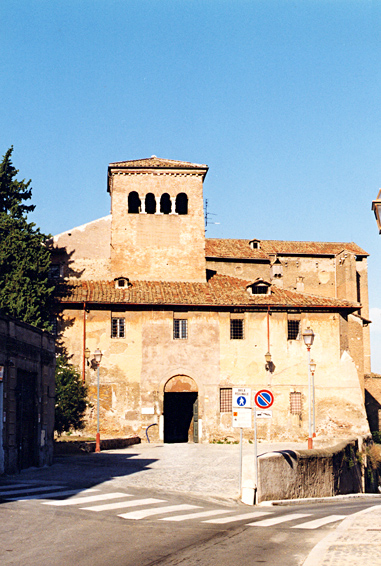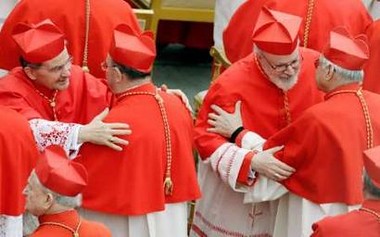Rome is about Love
 Station at the Four Holy Crowned Martyrs'
Station at the Four Holy Crowned Martyrs'The Station is on Mount Coelius, in a church erected in the 7th century in honour of four unknown officers of the Roman army who, having refused to adore a statue of Aesculapius, received the crown of martyrdom. These were the 'four crowned ones' whose relics are venerated in this sanctuary, together with the head of the martyr St Sebastian, an officer of the army of Diocletian. However, according to tradition, the site has been traced to the 4th century and the titulus Aemilianae, named after the foundress of an early parish church here. The church has been in the care of Augustinian nuns since 1560 and the current titular is Cardinal Mahoney of Los Angeles.
"Rejoice, Jerusalem! Be glad for her, you who love her; rejoice with her, you who mourned for her, and you will find contentment at her consoling breasts." (cf Is 66:10-11)
That was the Introit for yesterday, Laetare Sunday. As I did not comment on the liturgy yesterday, I would like to turn my attention to it today, to give it its due. In the liturgy, the mention of Jerusalem focuses our minds on the Church as the Holy City which is the source of catholic (hence, universal) unity. Hence, the custom arose on that day to travel to the Mother Church of a diocese, as the Cathedral church - being the seat of the Bishop - is the symbol of diocesan unity, of ecclesial communion.
Unity in the universal Church is very much a theme in yesterday's Liturgy and indeed also the focus of recent events in Rome - the Consistory. As Pope Benedict XVI said at that glorious occasion: "The ordinary public consistory is an event that manifests most eloquently the universal nature of the Church, which has spread to every corner of the world in order to proclaim to all people the Good News of Christ our Saviour." The cardinals express that universality and diversity of the Church but are gathered as one Sacred College around the Pope, who is the symbol of unity in the Church, the Vicar of Christ. In doing this, they express the very nature of the Church, as the sacrament of salvation, which is to unite all things in Christ; to be both the sign and means of unity in the world (cf Lumen Gentium, 1).
Thus, on a more parochial and personal level , Fr Geoffrey Preston, O.P. suggests that "the Church can be experienced, at least in germ, wherever and whenever we see a sign of unity between men which also functions as a means for furthering the unity of mankind". And this begins with the reconciliation of two people and the vocation to unity begins when two people come together. As such he goes on to say:
"The new and greater David, David's Son and David's Lord, Jesus of Nazareth, says that where two or three are gathered together in his name there he is in the midst of them. In any reconciliation of even two people, wherever two people become one spirit or one flesh, the Lord is at work and personally present, always there as the third.From this point of view 'church' is a verb rather than a noun. 'Church' refers to the work of reconciliation between men. This suggests how our religious communities within the Church are meant to function. They have a never-ending task of becoming truly one, of reducing multiplicity to a unity which stifles no one but opens up to us a share in the unity of the Father and the Son, what we call the Holy Spirit. St Augustine (above), whose Rule Dominicans follow and who stands at the head of the canonical way of life, explains that he and his monastic brethren are called 'monks' [from 'monos', single] because in their diversity they have become one in heart and mind, through the ardour of their love for the Christ who stands in the midst of them. We must never allow ourselves to settle for anything less than this monasticism, this becoming one, no matter how formidable the obstacles in its way. But whatever our particular vocation in the Church we must never belittle the Davidic task, the work of reconciliation within any group, large or small...
Every Christian life is directed to some form of oneness, communion, 'sobornost' as the Russians call it, with other men.
Not that it finishes there. By our baptism we are committed to being instruments, in one way or another, in the unifying of all mankind. Our local churches are gathered around the figure we call the bishop; and a bishop is precisely a sign and instrument of unity. All the extraordinarily enthusiastic things that Ignatius of Antioch has to say about bishops and their place in the Church are rooted in a sense of the bishop as a man of unity. Through his instrumentality in securing the concord and symphonic love of the Christian community, Jesus Christ is sung. And in the Church at large the Bishop of Rome has supremely the function of being a creative centre of unity, the expression of the mutual love of all the members of the body of Christ. You remember the ancient anagram: ROMA - AMOR. Rome is about love; and if it is not about love, it is nothing. But all of us, and not just the Roman pope, have a duty to fulfil the function of Rome and Jerusalem as well as we can in our local situation, never reconciling ourselves to the disunity of Christianity or to the disunity of the family of man, but always keeping our eyes open to ways in which we can further that unity which is God's will and plan for the world."
That is very much the Cardinals' task: to enflesh the love of Christ. As the Holy Father said last Friday:

"I am counting on you, venerable brothers, I am counting on the entire College into which you are being incorporated, to proclaim to the world that "Deus caritas est," and to do so above all through the witness of sincere communion among Christians: "By this," said Jesus, "all people will know that you are my disciples, if you have love for one another" (John 13:35).
I am counting on you, dear brother cardinals, to ensure that the principle of love will spread far and wide, and will give new life to the Church at every level of her hierarchy, in every group of the faithful, in every religious Institute, in every spiritual, apostolic or humanitarian initiative. I am counting on you to see to it that our common endeavor to fix our gaze on Christ's open Heart will hasten and secure our path toward the full unity of Christians.
I am counting on you to see to it that the Church's solicitude for the poor and needy challenges the world with a powerful statement on the civilization of love. All this I see symbolized in the scarlet with which you are now invested. May it truly be a symbol of ardent Christian love shining forth in your lives."
Let us not only support them in prayer but also by witnessing to Christ's love and reconciliation in our own lives and being instruments of unity ourselves, living stones in Christ's Holy Church.
May the Four Holy Martyrs and St Sebastian pray for us!







0 Comments:
Post a Comment
<< Home